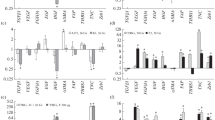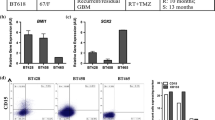Abstract
Ionizing radiation is a critical component of glioblastoma (GBM) therapy. Recent data have implicated glioblastoma stem-like cells (GSCs) as determinants of GBM development, maintenance, and treatment response. Understanding the response of GSCs to radiation should thus provide insight into the development of improved GBM treatment strategies. Towards this end, in vitro techniques for the analysis of GSC radiosensitivity are an essential starting point. One such method, the clonogenic survival assay has been adapted to assessing the intrinsic radiosensitivity of GSCs and is described here. As an alternative method, the limiting dilution assay is presented for defining the radiosensitivity of GSC lines that do not form colonies or only grow as neurospheres. In addition to these cellular strategies, we describe γH2AX foci analysis, which provides a surrogate marker for radiosensitivity at the molecular level. Taken together, the in vitro methods presented here provide tools for defining intrinsic radiosensitivity of GSCs and for testing agents that may enhance GBM radioresponse.
Access this chapter
Tax calculation will be finalised at checkout
Purchases are for personal use only
Similar content being viewed by others
References
Stupp R, Mason WP, van den Bent MJ et al (2005) Radiotherapy plus concomitant and adjuvant temozolomide for glioblastoma. N Engl J Med 352:987–996. https://doi.org/10.1056/NEJMoa043330
Ostrom QT, Gittleman H, Truitt G et al (2018) CBTRUS statistical report: primary brain and other central nervous system tumors diagnosed in the United States in 2011–2015. Neuro Oncol 20:iv1–iv86. https://doi.org/10.1093/neuonc/noy131
Giese A, Bjerkvig R, Berens ME, Westphal M (2003) Cost of migration: invasion of malignant gliomas and implications for treatment. J Clin Oncol 21:1624–1636. https://doi.org/10.1200/JCO.2003.05.063
Chan JL, Lee SW, Fraass BA et al (2002) Survival and failure patterns of high-grade gliomas after three-dimensional conformal radiotherapy. J Clin Oncol 20:1635–1642. https://doi.org/10.1200/JCO.2002.20.6.1635
Lee J, Kotliarova S, Kotliarov Y et al (2006) Tumor stem cells derived from glioblastomas cultured in bFGF and EGF more closely mirror the phenotype and genotype of primary tumors than do serum-cultured cell lines. Cancer Cell 9:391–403. https://doi.org/10.1016/j.ccr.2006.03.030
Galli R, Binda E, Orfanelli U et al (2004) Isolation and characterization of tumorigenic, stem-like neural precursors from human glioblastoma. Cancer Res 64:7011–7021. https://doi.org/10.1158/0008-5472.CAN-04-1364
Singh SK, Hawkins C, Clarke ID et al (2004) Identification of human brain tumour initiating cells. Nature 432:396–401. https://doi.org/10.1038/nature03128
Bao S, Wu Q, McLendon RE et al (2006) Glioma stem cells promote radioresistance by preferential activation of the DNA damage response. Nature 444:756–760. https://doi.org/10.1038/nature05236
McCord AM, Jamal M, Williams ES et al (2009) CD133+ glioblastoma stem-like cells are radiosensitive with a defective DNA damage response compared with established cell lines. Clin Cancer Res 15:5145–5153. https://doi.org/10.1158/1078-0432.CCR-09-0263
Hall EJ, Giaccia AJ (2012) Radiobiology for the radiologist, 7th edn. Lippincott Williams and Wilkins, Philadelphia
Pollard SM, Yoshikawa K, Clarke ID et al (2009) Glioma stem cell lines expanded in adherent culture have tumor-specific phenotypes and are suitable for chemical and genetic screens. Cell Stem Cell 4:568–580. https://doi.org/10.1016/j.stem.2009.03.014
McCord AM, Jamal M, Shankavaram UT et al (2009) Physiologic oxygen concentration enhances the stem-like properties of CD133+ human glioblastoma cells in vitro. Mol Cancer Res 7:489–497. https://doi.org/10.1158/1541-7786.MCR-08-0360
Grenman R, Burk D, Virolainen E et al (1989) Clonogenic cell assay for anchorage-dependent squamous carcinoma cell lines using limiting dilution. Int J Cancer 44:131–136
Venere M, Hamerlik P, Wu Q et al (2013) Therapeutic targeting of constitutive PARP activation compromises stem cell phenotype and survival of glioblastoma-initiating cells. Cell Death Differ 21:258–269. https://doi.org/10.1038/cdd.2013.136
Rogakou EP, Pilch DR, Orr AH et al (1998) DNA double-stranded breaks induce histone H2AX phosphorylation on serine 139. J Biol Chem 273:5858–5868. https://doi.org/10.1074/jbc.273.10.5858
Sedelnikova OA, Rogakou EP, Panyutin IG, Bonner WM (2002) Quantitative detection of (125)IdU-induced DNA double-strand breaks with gamma-H2AX antibody. Radiat Res 158:486–492
Banáth JP, MacPhail SH, Olive PL (2004) Radiation sensitivity, H2AX phosphorylation, and kinetics of repair of DNA strand breaks in irradiated cervical cancer cell lines. Cancer Res 64:7144–7149. https://doi.org/10.1158/0008-5472.CAN-04-1433
Olive PL, Banáth JP (2004) Phosphorylation of histone H2AX as a measure of radiosensitivity. Int J Radiat Oncol Biol Phys 58:331–335
Avondoglio D, Scott T, Kil W et al (2009) High throughput evaluation of gamma-H2AX. Radiat Oncol 4:31. https://doi.org/10.1186/1748-717X-4-31
Hu Y, Smyth GK (2009) ELDA: extreme limiting dilution analysis for comparing depleted and enriched populations in stem cell and other assays. J Immunol Methods 347:70–78. https://doi.org/10.1016/j.jim.2009.06.008
Acknowledgments
JHM is supported by the NIH OxCam and Gates Cambridge Scholarships.
Author information
Authors and Affiliations
Corresponding author
Editor information
Editors and Affiliations
Rights and permissions
Copyright information
© 2021 Springer Science+Business Media, LLC, part of Springer Nature
About this protocol
Cite this protocol
McAbee, J.H., Degorre-Kerbaul, C., Tofilon, P.J. (2021). In Vitro Methods for the Study of Glioblastoma Stem-Like Cell Radiosensitivity. In: Stock, P., Christ, B. (eds) In Vitro Models for Stem Cell Therapy. Methods in Molecular Biology, vol 2269. Humana, New York, NY. https://doi.org/10.1007/978-1-0716-1225-5_3
Download citation
DOI: https://doi.org/10.1007/978-1-0716-1225-5_3
Published:
Publisher Name: Humana, New York, NY
Print ISBN: 978-1-0716-1224-8
Online ISBN: 978-1-0716-1225-5
eBook Packages: Springer Protocols




